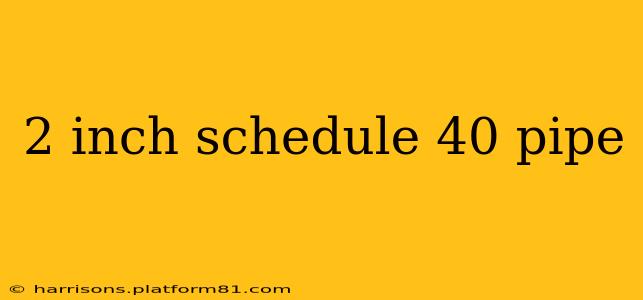Choosing the right pipe for your project is crucial, and understanding the specifications is key. This guide delves into the specifics of 2-inch Schedule 40 pipe, covering its dimensions, applications, and frequently asked questions. We'll go beyond the basics to provide you with the information you need to make informed decisions.
What is Schedule 40 Pipe?
Schedule 40 pipe is a standardized pipe designation indicating its wall thickness. The "Schedule" number refers to the pipe's pressure rating; a higher schedule number signifies a thicker wall and therefore greater pressure resistance. Schedule 40 is a common choice for many applications due to its balance of strength and cost-effectiveness. It's widely used for various purposes, from plumbing to industrial processes.
What are the Dimensions of 2-Inch Schedule 40 Pipe?
The exact dimensions of 2-inch Schedule 40 pipe vary slightly depending on the material (typically steel, PVC, or CPVC), but the nominal size remains consistent. Key dimensions include:
- Nominal Pipe Size (NPS): 2 inches. Note that this is a nominal size, and the actual inside diameter is slightly smaller.
- Outside Diameter (OD): Approximately 2.375 inches. This is a fairly consistent measurement across materials.
- Wall Thickness: This varies slightly by material but is around 0.154 inches for steel.
It's always best to consult the manufacturer's specifications for precise measurements for your chosen material. Slight variations can exist due to manufacturing tolerances.
What is 2-Inch Schedule 40 Pipe Used For?
The versatility of 2-inch Schedule 40 pipe makes it suitable for a wide range of applications, including:
- Plumbing Systems: For carrying water, both hot and cold, in residential, commercial, and industrial settings.
- Irrigation Systems: Transporting water for agricultural or landscaping purposes.
- Industrial Processes: Used in various industrial applications to convey fluids, gases, or other materials.
- Compressed Air Systems: Capable of handling compressed air in various settings.
The choice of material (steel, PVC, CPVC) will often dictate the specific application, based on factors like chemical compatibility and temperature resistance.
What is the Pressure Rating of 2-Inch Schedule 40 Pipe?
The pressure rating depends significantly on the pipe material and the fluid being transported. The Schedule 40 designation itself does not directly specify a pressure rating in PSI (pounds per square inch). Instead, Schedule 40 indicates the wall thickness, which directly influences its pressure resistance. Consult the manufacturer's data sheets for the specific pressure rating of the pipe material you are using and the operating conditions (temperature, fluid type).
What is the difference between Schedule 40 and other schedules?
Schedule 40 pipe is a common choice, but other schedules exist offering different wall thicknesses and pressure ratings:
- Schedule 80: Offers thicker walls and higher pressure resistance compared to Schedule 40. It's used when higher pressures are involved.
- Schedule 160: Has even thicker walls and a substantially higher pressure rating. This is typically used in demanding applications requiring extreme pressure resistance.
Choosing the appropriate schedule is critical for ensuring the integrity and safety of the piping system.
How do I calculate the flow rate of 2-inch Schedule 40 pipe?
Calculating flow rate involves several factors, including the pipe's inside diameter, the fluid's viscosity, and the pressure drop along the pipe. The Hazen-Williams equation or the Darcy-Weisbach equation are commonly used for this calculation. These equations require specific parameters and are best solved using engineering software or online calculators specifically designed for fluid flow calculations. This is not a simple calculation, and professional help might be needed for accurate results.
This comprehensive guide provides a detailed understanding of 2-inch Schedule 40 pipe. Remember to always consult manufacturer specifications for precise dimensions and pressure ratings relevant to your specific material and application. Using the correct pipe for your project ensures safety, longevity, and efficient performance.
